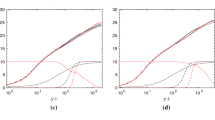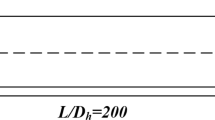Abstract
In the present study, numerical assessment of the \(\gamma - {\text{Re}}_{\theta t} - {\text{CF}}^{ + }\) transition model was carried out using a Reynolds-averaged Navier–Stokes (RANS) computational fluid dynamics (CFD) flow solver based on unstructured meshes. A three-dimensional bump-in-channel verification case was first tested in a fully turbulent manner to verify the implementation of the \(k - {\upomega }\) shear stress transport turbulence model, which was coupled with the laminar-turbulent transition model. In addition, to validate the \(\gamma - {\text{Re}}_{\theta t} - {\text{CF}}^{ + }\) transition model, transition onset locations were compared with the experimental results for three angles-of-attack with a 6:1 prolate spheroid configuration. Then, the \(\gamma - {\text{Re}}_{\theta t} - {\text{CF}}^{ + }\) transition model was utilized to predict the skin friction distributions, surface pressure distributions, and transition onset locations of the natural-laminar-flow version of the common research model (CRM-NLF). For this purpose, a grid-resolution study was carried out for a fixed angle-of-attack on coarse, medium, and fine meshes. The aerodynamic performance of the CRM-NFL was compared with the experimental for four angles of attack.









Similar content being viewed by others
Abbreviations
- \(\gamma\) :
-
Intermittency
- \({\text{Re}}_{\theta t}\) :
-
Momentum thickness Reynolds number at transition onset, streamwise
- \({\text{CF}}^{ + }\) :
-
Cross-flow plus
- \({\text{RANS}}\) :
-
Reynolds-averaged Navier–Stokes
- \({\text{CFD}}\) :
-
Computational fluid dynamics
- \(k\) :
-
Turbulence kinetic energy
- \(\omega\) :
-
Specific turbulence dissipation rate
- \({\text{CRM}}\) :
-
Common research model
- \({\text{NLF}}\) :
-
Natural-laminar flow
- \({\text{MPI}}\) :
-
Massage passing interface
- \({\text{SST}}\) :
-
Shear stress transport
- \(P_{\gamma }\) :
-
Production term in transport equation for the intermittency
- \(D_{\gamma }\) :
-
Destruction term in transport equation for the intermittency
- \(S\) :
-
Strain rate magnitude
- \(\Omega\) :
-
Vorticity magnitude
- \(F_{{{\text{onset1\_3D}}}}\) :
-
Transition length function
- \({\text{Re}}_{\delta 2c}\) :
-
Displacement thickness Reynolds number at transition onset, crosswise (transition criterion)
- \(\theta\) :
-
Momentum thickness, streamwise
- \(\mu\) :
-
Molecular viscosity
- \(\mu_{{\text{t}}}\) :
-
Eddy viscosity
- \(\rho\) :
-
Density
- \(\phi\) :
-
Local sweep angle
- \(y^{ + }\) :
-
Non-dimensional distance from the wall to the first mesh node
- \(P_{{\text{t}}}\) :
-
Total pressure
- \(P_{{{\text{ref}}}}\) :
-
Pressure at reference point
- \(T_{{\text{t}}}\) :
-
Total temperature
- \(T_{{{\text{ref}}}}\) :
-
Temperature at reference point
- \(P\) :
-
Pressure
- \(k_{\infty }\) :
-
Freestream turbulence kinetic energy
- \(\omega_{\infty }\) :
-
Freestream specific rate of dissipation
- \(a_{\infty }\) :
-
Freestream speed of sound
- \(\mu_{\infty }\) :
-
Viscosity of the freestream
- \(\rho_{\infty }\) :
-
Freestream density
- \({\text{TI}}\) :
-
Turbulence intensity
- \(M_{\infty }\) :
-
Freestream Mach number
- \(L^{*}\) :
-
Non-dimensional length from the object to the far-field
- \(\eta\) :
-
Spanwise location
- \(d\) :
-
Wall distance vector
- \(\widetilde{r}\) :
-
Reynolds number ratio, crosswise
- \(\lambda_{\theta }\) :
-
Pressure gradient parameter
References
Medida S, Baeder J (2013) A new crossflow transition onset criterion for RANS turbulence models. In: Paper presented at the 21st AIAA computational fluid dynamics conference, 24–27 June, San Diego. https://doi.org/10.2514/6.2013-3081
Jain R (2017) CFD performance and turbulence transition predictions on an installed model-scale rotor in hover. In: Paper presented at the 55th AIAA Aerospace Sciences Meetings, 9–13 January, Grapevine. https://doi.org/10.2514/6.2017-1871
Langtry RB, Menter FR (2009) Correlation-based transition modeling for unstructured parallelized computational fluid dynamics codes. AIAA J 47(12):2894–2906. https://doi.org/10.2514/1.42362
Watanabe Y, Misaka T, Obayashi S, Arima T, Yamaguchi Y (2009) Application of crossflow transition criteria to local correlation-based transition model. In: Paper presented at the 47th AIAA aerospace science meetings, 5–8 January, Orlando. https://doi.org/10.2514/6.2009-1145
Grabe C, Krumbein A (2013) Correlation-based transition transport modeling for three-dimensional aerodynamic configurations. J Aircr 50(5):1533–1539. https://doi.org/10.2514/1.C032063
Choi JH, Kwon OJ (2017) Recent improvement of a correlation-based transition model for simulating three-dimensional boundary layers. AIAA J 55(6):2013–2018. https://doi.org/10.2514/1.J055182
Meier HU, Kreplin HP (1980) Experimental investigation of the boundary layer transition and separation on a body of revolution. Z für Flugwiss und Weltraumforsch 4:65–71
Boris D, Thomas JL, Pandya MJ, Rumsey CL (2016) Reference solutions for benchmark three dimensional turbulent flows. In: Proceedings of the AIAA Scitech 2016 Forum, 4–8 January, San Diego. https://doi.org/10.2514/6.2016-0858
Kreplin HP, Meier HU, Maier A (1978) Wind tunnel model and measuring techniques for the investigation of three-dimensional turbulent boundary layers. In: Proceedings of the 10th AIAA aerodynamic testing conference, San Diego. https://doi.org/10.2514/6.1978-781
Kreplin HP, Vollmers H, Meier HU (1985) Wall shear stress measurements on an inclined prolate spheroid in the DFVLR 3 m × 3 m low speed wind tunnel, Göttingen. Deutsche Forschungs and Versuchsanstalt für Luft und Raumfahrt Rept 33:222–284
Lynde MN, Campbell RL, Rivers MB, Viken SA, Chan DT, Watkins AN (2019) Preliminary results from an experimental assessment of a natural laminar flow design method. In: Proceedings of the AIAA Scitech 2019 Forum, 7–11 January, San Diego. https://doi.org/10.2514/6.1978-781
Lynde MN, Campbell RL, Viken SA (2019) Additional findings from the common research model natural laminar flow wind tunnel test. In: Proceedings of the AIAA aviation 2019 forum, 17–21 June 2019, Dallas. https://doi.org/10.2514/6.2019-3292
Jung MS, Kwon OJ, Kang HJ (2007) Assessment of rotor hover performance using a node-based flow solver. Int J Aeronaut Space Sci 8(2):44–45
Roe PL (1981) Approximate Riemann solvers, parameter vectors and difference. J Comput Phys 43(2):357–372. https://doi.org/10.1016/0021-9991(81)90128-5
Mathur SR, Murthy JY (1997) A pressure-based method for unstructured meshes. Numer Heat Transf 31(2):195–215. https://doi.org/10.1080/10407799708915105
Venkatakrishnan V (1995) Convergence to steady state solutions of the Euler equations on unstructured grids with limiters. J Comput Phys 118(1):120–130. https://doi.org/10.1006/jcph.1995.1084
Karypis G, Kumar V (1998) Multilevel k-way partitioning schemes for irregular graphs. J Parallel Distrib Comput 48(1):96–129
Cooke JC (1950) The boundary layer of a class of infinite yawed cylinders. Math Proc Camb Philos Soc 46(4):645–648. https://doi.org/10.1017/S0305004100026220
Coder JG (2018) Standard test cases for transition model verification and validation in computational fluid dynamics. In: Proceedings of the AIAA Scitech 2018 Forum, 8–12 January, Kissimmee. https://doi.org/10.2514/6.2018-0029
Menter FR, Smirnov PE, Liu T, Avancah R (2015) A one-equation local correlation-based transition model. Flow Turbul Combust 95:583–619. https://doi.org/10.1007/s10494-015-9622-4
Park SH, Kwon OJ (2021) Numerical study of effects of fuselage and facility wall on PSP rotor performance in hover. Int J Aeronaut Space Sci. https://doi.org/10.1007/s42405-021-00420-9
Park SH, Han J, Kwon OJ (2021) Numerical study of HVAB rotor using a mixed mesh flow solver. In: Proceedings of the AIAA Scitech 2021 Forum, 11–15 & 19–21 January 2021, Online event. https://doi.org/10.2514/6.2021-0619
Jung YS, Lee B, Baeder J (2021) Validation of SA- turbulence/transition models. In: Proceedings of the 1st AIAA transition modeling and prediction workshop, 21–22 January, Online event
Zore K, Shah S, Matyushenko A (NTS), Menter F, Stokes J (2021) Ansys submission to 1st AIAA transition modeling prediction workshop. In: Proceedings of the 1st AIAA transition modeling and prediction workshop, 21–22 January, Online event.
Denison M (2021) Lantry–Menter model based simulation in OVERFLOW. In: Proceedings of the 1st AIAA transition modeling and prediction workshop, 21–22 January, Online event.
Acknowledgements
This work was conducted at High-Speed Compound Unmanned Rotorcraft (HCUR) research laboratory with the support of Agency for Defense Development (ADD).
Author information
Authors and Affiliations
Corresponding author
Additional information
Publisher's Note
Springer Nature remains neutral with regard to jurisdictional claims in published maps and institutional affiliations.
Rights and permissions
About this article
Cite this article
Park, S.H., Han, J. & Kwon, O.J. Prediction and Analysis of Transitional Crossflows Using \(\gamma - {\text{Re}}_{\theta t} - {\text{CF}}^{ + }\) Model. Int. J. Aeronaut. Space Sci. 23, 461–470 (2022). https://doi.org/10.1007/s42405-022-00457-4
Received:
Revised:
Accepted:
Published:
Issue Date:
DOI: https://doi.org/10.1007/s42405-022-00457-4




